Population Distribution in Australia: A GEO151 Project Analysis
VerifiedAdded on 2023/04/20
|13
|3648
|215
Project
AI Summary
This project analyzes the demographic information and population distribution of Australia. It begins by introducing the topic, highlighting the diverse population distribution across different states and territories, with a focus on the capital territory's high population density. The project uses Google Earth for spatial data and mapping, illustrating population density variations across the country, including coastal areas, deserts, and major cities. It describes the spatial patterns observed, noting the concentration of population in coastal regions due to factors like water availability, immigration, and economic opportunities. The project then generates and tests a spatial hypothesis linking population density to urban settlement, amenities, and climate. The analysis considers factors such as climate, immigration, fertile land, and transportation systems, which influence population distribution. The project also includes a discussion on the historical context, economic factors, and government policies impacting population trends, concluding with an overview of the population growth and diversification in Australia.
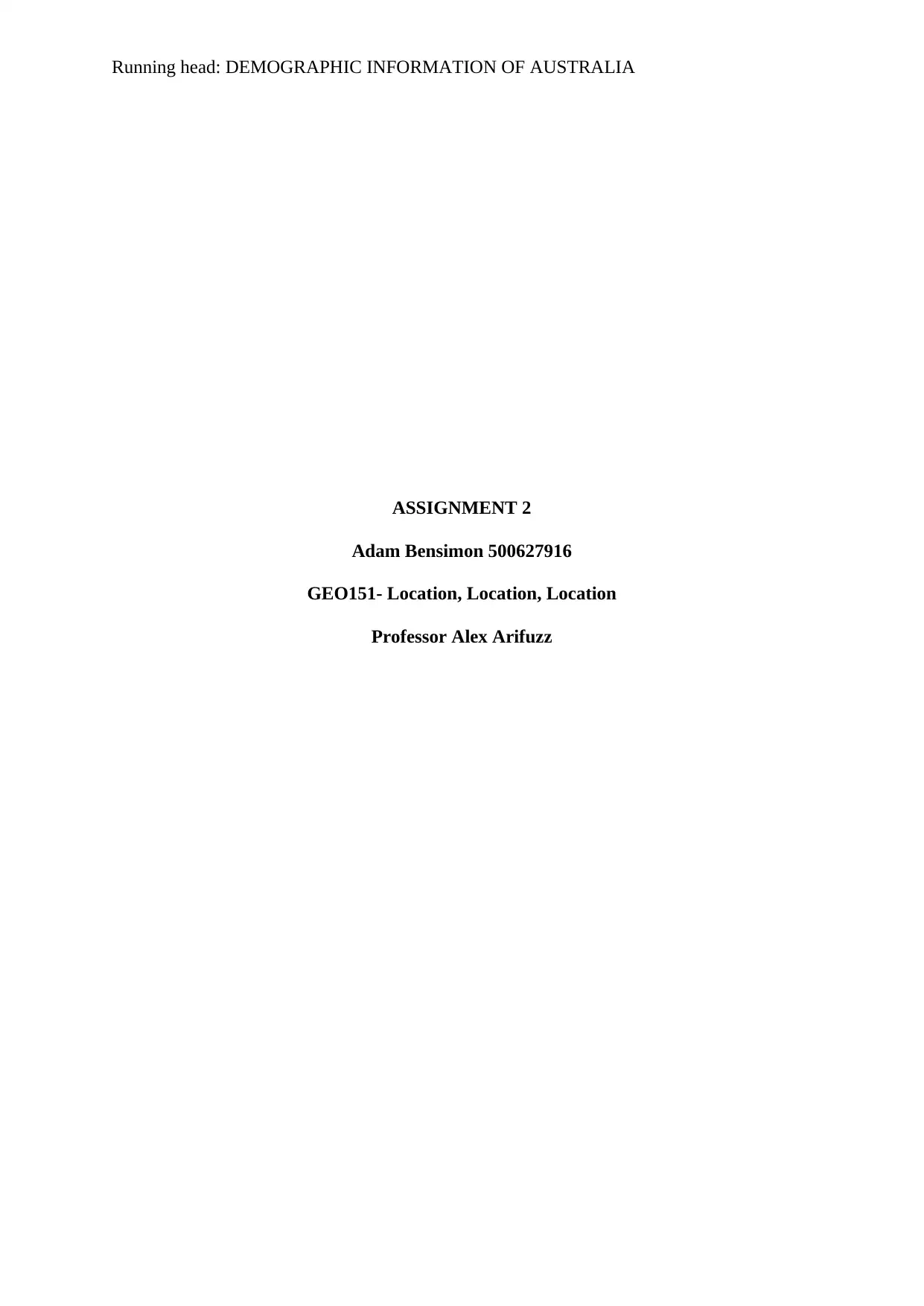
Running head: DEMOGRAPHIC INFORMATION OF AUSTRALIA
ASSIGNMENT 2
Adam Bensimon 500627916
GEO151- Location, Location, Location
Professor Alex Arifuzz
ASSIGNMENT 2
Adam Bensimon 500627916
GEO151- Location, Location, Location
Professor Alex Arifuzz
Paraphrase This Document
Need a fresh take? Get an instant paraphrase of this document with our AI Paraphraser
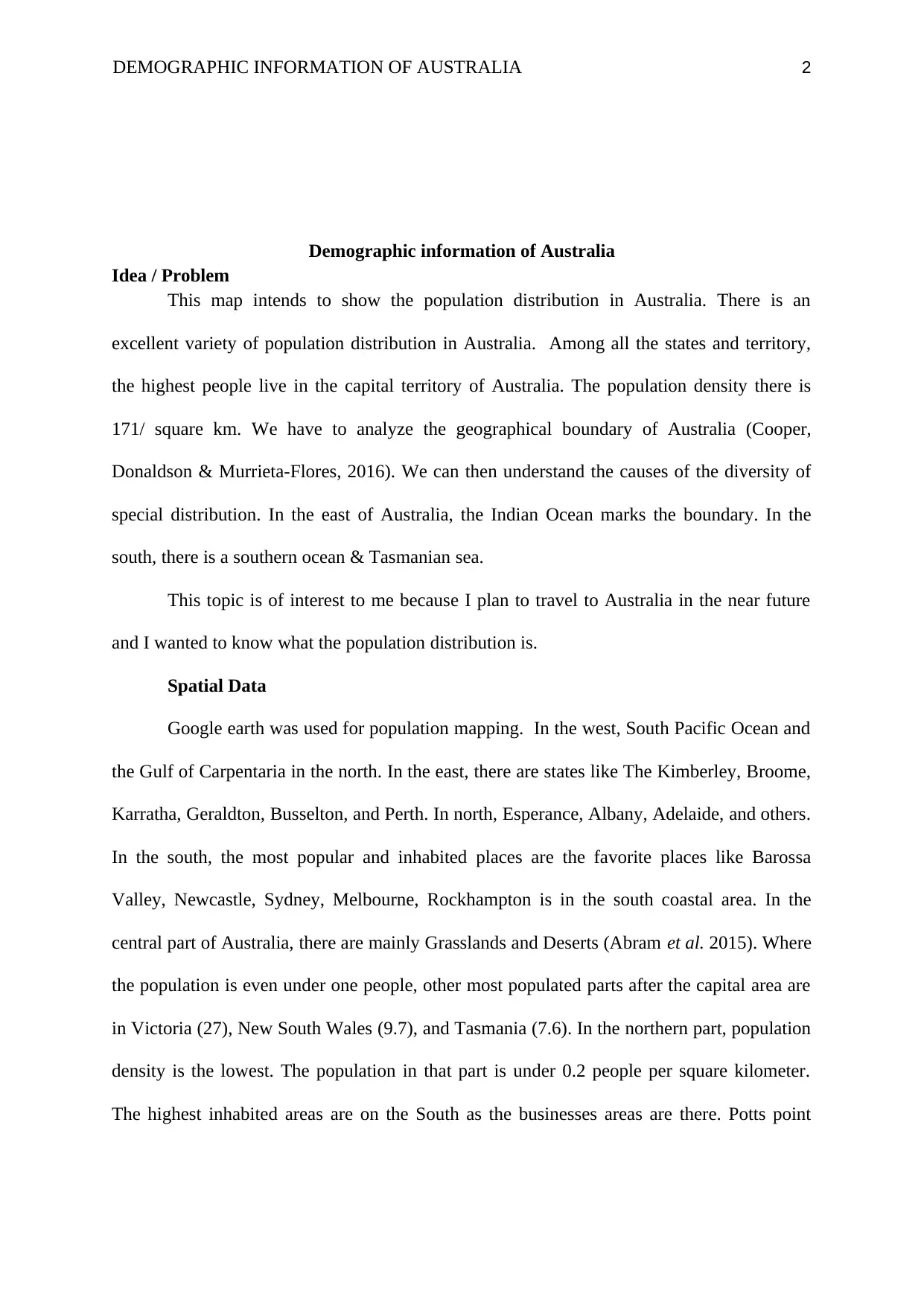
DEMOGRAPHIC INFORMATION OF AUSTRALIA 2
Demographic information of Australia
Idea / Problem
This map intends to show the population distribution in Australia. There is an
excellent variety of population distribution in Australia. Among all the states and territory,
the highest people live in the capital territory of Australia. The population density there is
171/ square km. We have to analyze the geographical boundary of Australia (Cooper,
Donaldson & Murrieta-Flores, 2016). We can then understand the causes of the diversity of
special distribution. In the east of Australia, the Indian Ocean marks the boundary. In the
south, there is a southern ocean & Tasmanian sea.
This topic is of interest to me because I plan to travel to Australia in the near future
and I wanted to know what the population distribution is.
Spatial Data
Google earth was used for population mapping. In the west, South Pacific Ocean and
the Gulf of Carpentaria in the north. In the east, there are states like The Kimberley, Broome,
Karratha, Geraldton, Busselton, and Perth. In north, Esperance, Albany, Adelaide, and others.
In the south, the most popular and inhabited places are the favorite places like Barossa
Valley, Newcastle, Sydney, Melbourne, Rockhampton is in the south coastal area. In the
central part of Australia, there are mainly Grasslands and Deserts (Abram et al. 2015). Where
the population is even under one people, other most populated parts after the capital area are
in Victoria (27), New South Wales (9.7), and Tasmania (7.6). In the northern part, population
density is the lowest. The population in that part is under 0.2 people per square kilometer.
The highest inhabited areas are on the South as the businesses areas are there. Potts point
Demographic information of Australia
Idea / Problem
This map intends to show the population distribution in Australia. There is an
excellent variety of population distribution in Australia. Among all the states and territory,
the highest people live in the capital territory of Australia. The population density there is
171/ square km. We have to analyze the geographical boundary of Australia (Cooper,
Donaldson & Murrieta-Flores, 2016). We can then understand the causes of the diversity of
special distribution. In the east of Australia, the Indian Ocean marks the boundary. In the
south, there is a southern ocean & Tasmanian sea.
This topic is of interest to me because I plan to travel to Australia in the near future
and I wanted to know what the population distribution is.
Spatial Data
Google earth was used for population mapping. In the west, South Pacific Ocean and
the Gulf of Carpentaria in the north. In the east, there are states like The Kimberley, Broome,
Karratha, Geraldton, Busselton, and Perth. In north, Esperance, Albany, Adelaide, and others.
In the south, the most popular and inhabited places are the favorite places like Barossa
Valley, Newcastle, Sydney, Melbourne, Rockhampton is in the south coastal area. In the
central part of Australia, there are mainly Grasslands and Deserts (Abram et al. 2015). Where
the population is even under one people, other most populated parts after the capital area are
in Victoria (27), New South Wales (9.7), and Tasmania (7.6). In the northern part, population
density is the lowest. The population in that part is under 0.2 people per square kilometer.
The highest inhabited areas are on the South as the businesses areas are there. Potts point
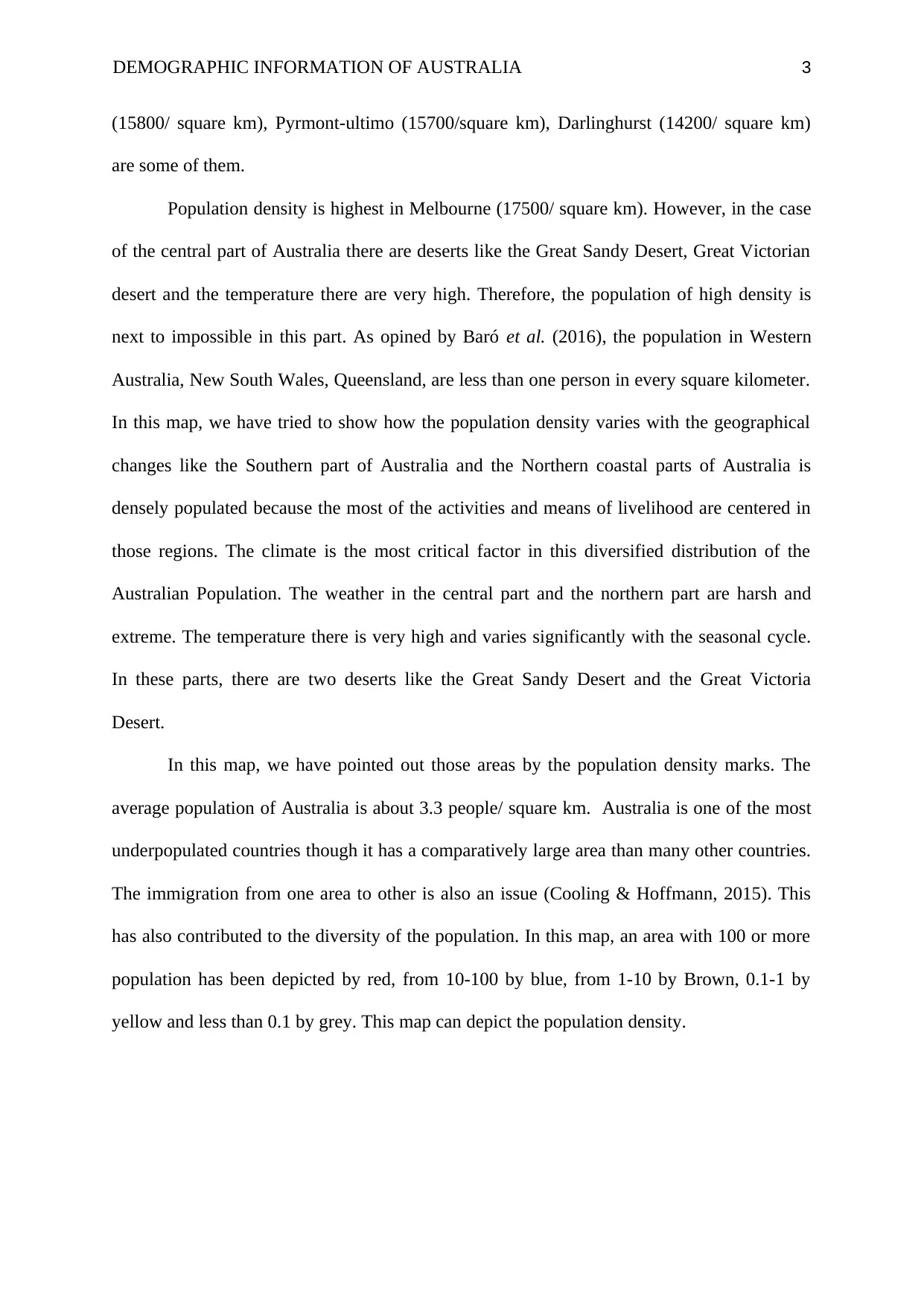
DEMOGRAPHIC INFORMATION OF AUSTRALIA 3
(15800/ square km), Pyrmont-ultimo (15700/square km), Darlinghurst (14200/ square km)
are some of them.
Population density is highest in Melbourne (17500/ square km). However, in the case
of the central part of Australia there are deserts like the Great Sandy Desert, Great Victorian
desert and the temperature there are very high. Therefore, the population of high density is
next to impossible in this part. As opined by Baró et al. (2016), the population in Western
Australia, New South Wales, Queensland, are less than one person in every square kilometer.
In this map, we have tried to show how the population density varies with the geographical
changes like the Southern part of Australia and the Northern coastal parts of Australia is
densely populated because the most of the activities and means of livelihood are centered in
those regions. The climate is the most critical factor in this diversified distribution of the
Australian Population. The weather in the central part and the northern part are harsh and
extreme. The temperature there is very high and varies significantly with the seasonal cycle.
In these parts, there are two deserts like the Great Sandy Desert and the Great Victoria
Desert.
In this map, we have pointed out those areas by the population density marks. The
average population of Australia is about 3.3 people/ square km. Australia is one of the most
underpopulated countries though it has a comparatively large area than many other countries.
The immigration from one area to other is also an issue (Cooling & Hoffmann, 2015). This
has also contributed to the diversity of the population. In this map, an area with 100 or more
population has been depicted by red, from 10-100 by blue, from 1-10 by Brown, 0.1-1 by
yellow and less than 0.1 by grey. This map can depict the population density.
(15800/ square km), Pyrmont-ultimo (15700/square km), Darlinghurst (14200/ square km)
are some of them.
Population density is highest in Melbourne (17500/ square km). However, in the case
of the central part of Australia there are deserts like the Great Sandy Desert, Great Victorian
desert and the temperature there are very high. Therefore, the population of high density is
next to impossible in this part. As opined by Baró et al. (2016), the population in Western
Australia, New South Wales, Queensland, are less than one person in every square kilometer.
In this map, we have tried to show how the population density varies with the geographical
changes like the Southern part of Australia and the Northern coastal parts of Australia is
densely populated because the most of the activities and means of livelihood are centered in
those regions. The climate is the most critical factor in this diversified distribution of the
Australian Population. The weather in the central part and the northern part are harsh and
extreme. The temperature there is very high and varies significantly with the seasonal cycle.
In these parts, there are two deserts like the Great Sandy Desert and the Great Victoria
Desert.
In this map, we have pointed out those areas by the population density marks. The
average population of Australia is about 3.3 people/ square km. Australia is one of the most
underpopulated countries though it has a comparatively large area than many other countries.
The immigration from one area to other is also an issue (Cooling & Hoffmann, 2015). This
has also contributed to the diversity of the population. In this map, an area with 100 or more
population has been depicted by red, from 10-100 by blue, from 1-10 by Brown, 0.1-1 by
yellow and less than 0.1 by grey. This map can depict the population density.
⊘ This is a preview!⊘
Do you want full access?
Subscribe today to unlock all pages.

Trusted by 1+ million students worldwide
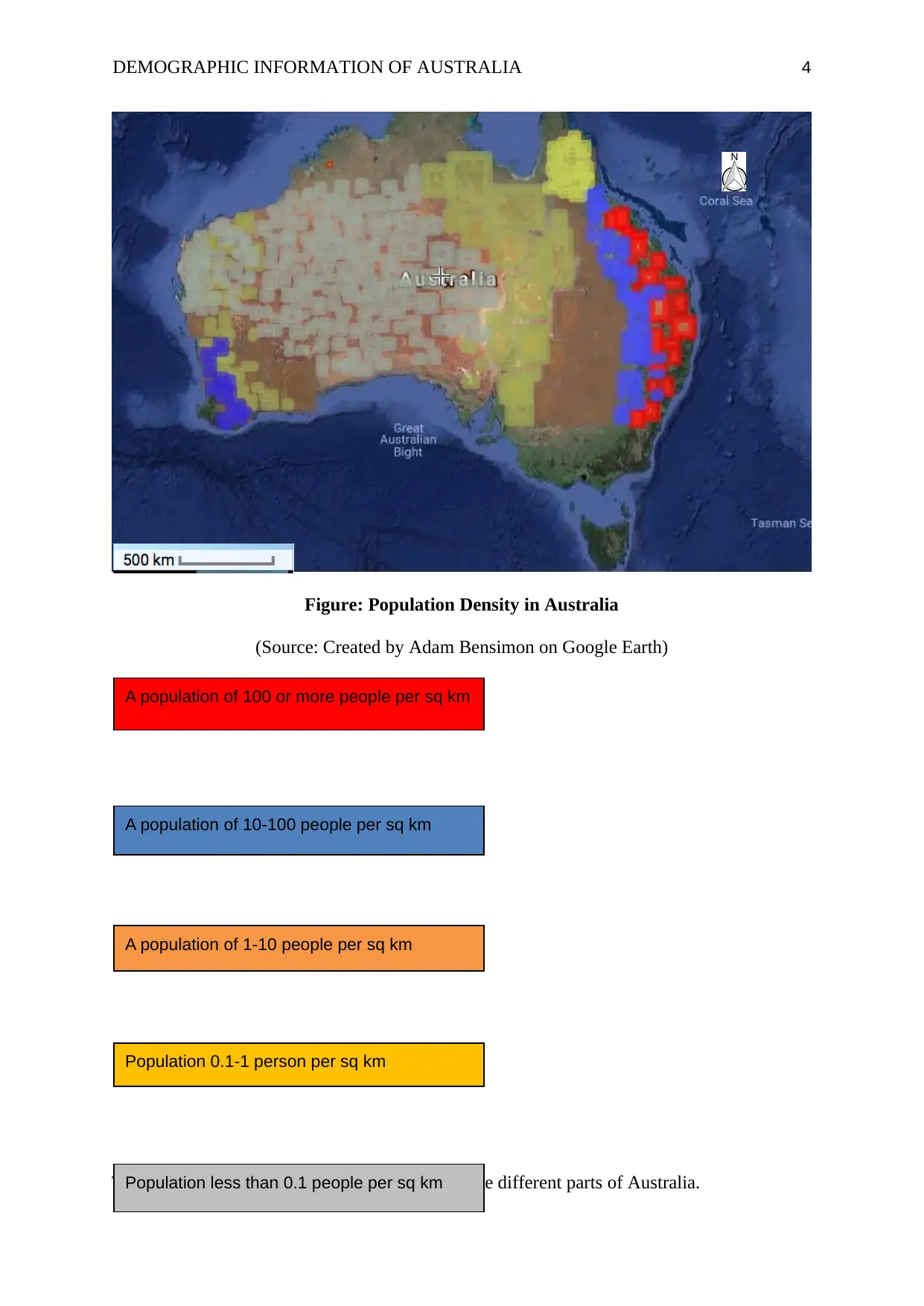
DEMOGRAPHIC INFORMATION OF AUSTRALIA 4
Figure: Population Density in Australia
(Source: Created by Adam Bensimon on Google Earth)
The map is presenting the population density in the different parts of Australia.
A population of 100 or more people per sq km
A population of 10-100 people per sq km
A population of 1-10 people per sq km
Population 0.1-1 person per sq km
Population less than 0.1 people per sq km
Figure: Population Density in Australia
(Source: Created by Adam Bensimon on Google Earth)
The map is presenting the population density in the different parts of Australia.
A population of 100 or more people per sq km
A population of 10-100 people per sq km
A population of 1-10 people per sq km
Population 0.1-1 person per sq km
Population less than 0.1 people per sq km
Paraphrase This Document
Need a fresh take? Get an instant paraphrase of this document with our AI Paraphraser
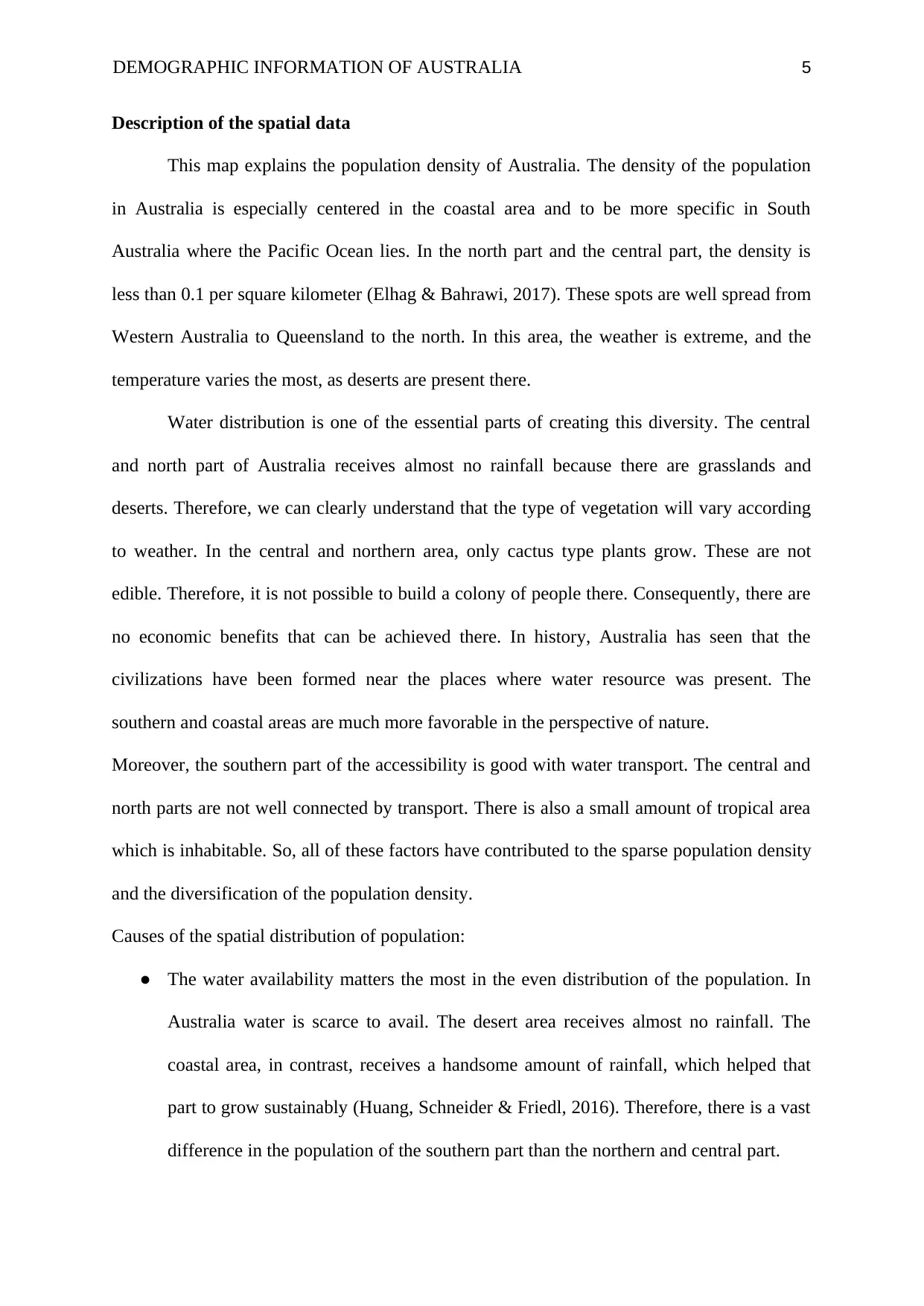
DEMOGRAPHIC INFORMATION OF AUSTRALIA 5
Description of the spatial data
This map explains the population density of Australia. The density of the population
in Australia is especially centered in the coastal area and to be more specific in South
Australia where the Pacific Ocean lies. In the north part and the central part, the density is
less than 0.1 per square kilometer (Elhag & Bahrawi, 2017). These spots are well spread from
Western Australia to Queensland to the north. In this area, the weather is extreme, and the
temperature varies the most, as deserts are present there.
Water distribution is one of the essential parts of creating this diversity. The central
and north part of Australia receives almost no rainfall because there are grasslands and
deserts. Therefore, we can clearly understand that the type of vegetation will vary according
to weather. In the central and northern area, only cactus type plants grow. These are not
edible. Therefore, it is not possible to build a colony of people there. Consequently, there are
no economic benefits that can be achieved there. In history, Australia has seen that the
civilizations have been formed near the places where water resource was present. The
southern and coastal areas are much more favorable in the perspective of nature.
Moreover, the southern part of the accessibility is good with water transport. The central and
north parts are not well connected by transport. There is also a small amount of tropical area
which is inhabitable. So, all of these factors have contributed to the sparse population density
and the diversification of the population density.
Causes of the spatial distribution of population:
● The water availability matters the most in the even distribution of the population. In
Australia water is scarce to avail. The desert area receives almost no rainfall. The
coastal area, in contrast, receives a handsome amount of rainfall, which helped that
part to grow sustainably (Huang, Schneider & Friedl, 2016). Therefore, there is a vast
difference in the population of the southern part than the northern and central part.
Description of the spatial data
This map explains the population density of Australia. The density of the population
in Australia is especially centered in the coastal area and to be more specific in South
Australia where the Pacific Ocean lies. In the north part and the central part, the density is
less than 0.1 per square kilometer (Elhag & Bahrawi, 2017). These spots are well spread from
Western Australia to Queensland to the north. In this area, the weather is extreme, and the
temperature varies the most, as deserts are present there.
Water distribution is one of the essential parts of creating this diversity. The central
and north part of Australia receives almost no rainfall because there are grasslands and
deserts. Therefore, we can clearly understand that the type of vegetation will vary according
to weather. In the central and northern area, only cactus type plants grow. These are not
edible. Therefore, it is not possible to build a colony of people there. Consequently, there are
no economic benefits that can be achieved there. In history, Australia has seen that the
civilizations have been formed near the places where water resource was present. The
southern and coastal areas are much more favorable in the perspective of nature.
Moreover, the southern part of the accessibility is good with water transport. The central and
north parts are not well connected by transport. There is also a small amount of tropical area
which is inhabitable. So, all of these factors have contributed to the sparse population density
and the diversification of the population density.
Causes of the spatial distribution of population:
● The water availability matters the most in the even distribution of the population. In
Australia water is scarce to avail. The desert area receives almost no rainfall. The
coastal area, in contrast, receives a handsome amount of rainfall, which helped that
part to grow sustainably (Huang, Schneider & Friedl, 2016). Therefore, there is a vast
difference in the population of the southern part than the northern and central part.
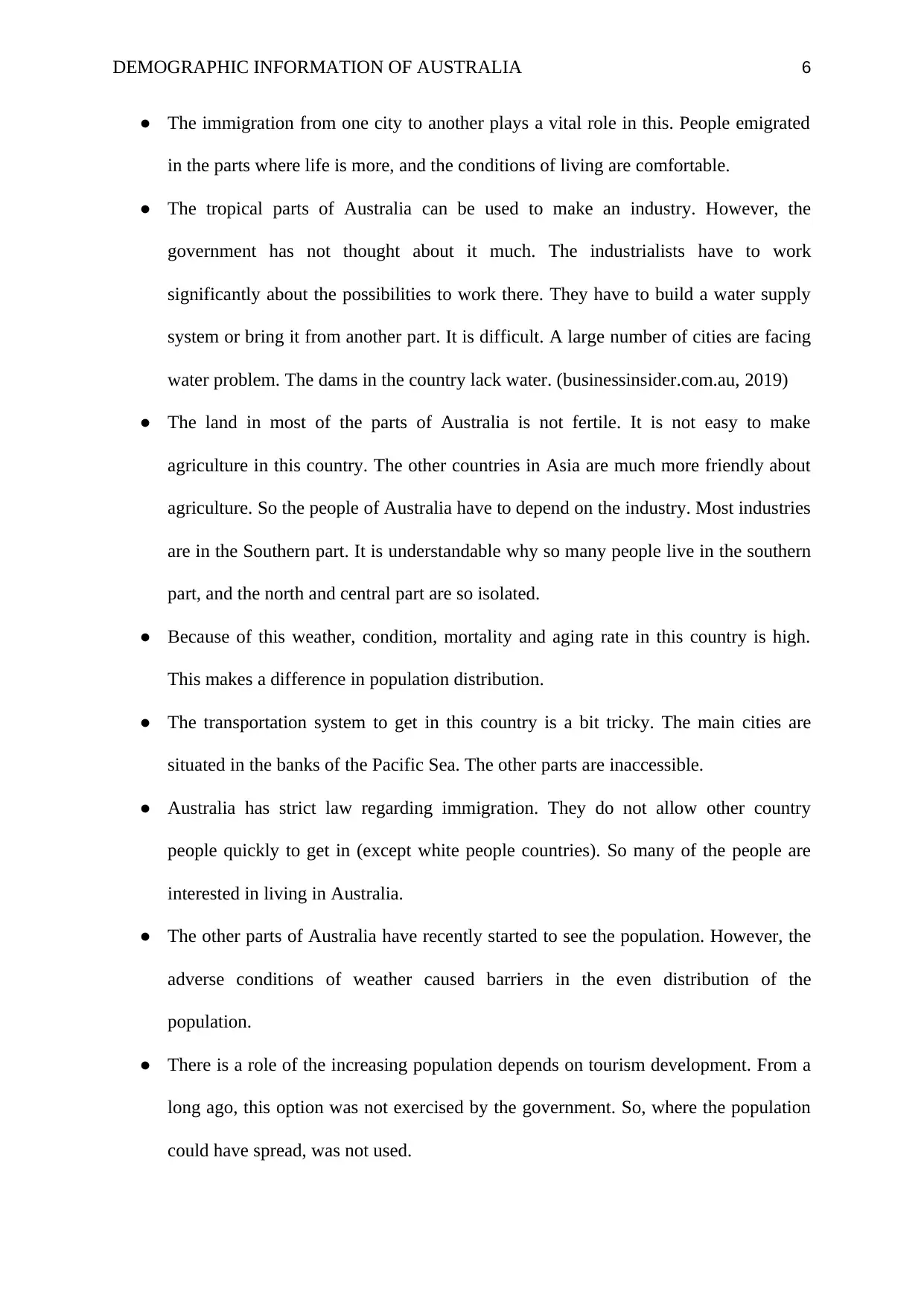
DEMOGRAPHIC INFORMATION OF AUSTRALIA 6
● The immigration from one city to another plays a vital role in this. People emigrated
in the parts where life is more, and the conditions of living are comfortable.
● The tropical parts of Australia can be used to make an industry. However, the
government has not thought about it much. The industrialists have to work
significantly about the possibilities to work there. They have to build a water supply
system or bring it from another part. It is difficult. A large number of cities are facing
water problem. The dams in the country lack water. (businessinsider.com.au, 2019)
● The land in most of the parts of Australia is not fertile. It is not easy to make
agriculture in this country. The other countries in Asia are much more friendly about
agriculture. So the people of Australia have to depend on the industry. Most industries
are in the Southern part. It is understandable why so many people live in the southern
part, and the north and central part are so isolated.
● Because of this weather, condition, mortality and aging rate in this country is high.
This makes a difference in population distribution.
● The transportation system to get in this country is a bit tricky. The main cities are
situated in the banks of the Pacific Sea. The other parts are inaccessible.
● Australia has strict law regarding immigration. They do not allow other country
people quickly to get in (except white people countries). So many of the people are
interested in living in Australia.
● The other parts of Australia have recently started to see the population. However, the
adverse conditions of weather caused barriers in the even distribution of the
population.
● There is a role of the increasing population depends on tourism development. From a
long ago, this option was not exercised by the government. So, where the population
could have spread, was not used.
● The immigration from one city to another plays a vital role in this. People emigrated
in the parts where life is more, and the conditions of living are comfortable.
● The tropical parts of Australia can be used to make an industry. However, the
government has not thought about it much. The industrialists have to work
significantly about the possibilities to work there. They have to build a water supply
system or bring it from another part. It is difficult. A large number of cities are facing
water problem. The dams in the country lack water. (businessinsider.com.au, 2019)
● The land in most of the parts of Australia is not fertile. It is not easy to make
agriculture in this country. The other countries in Asia are much more friendly about
agriculture. So the people of Australia have to depend on the industry. Most industries
are in the Southern part. It is understandable why so many people live in the southern
part, and the north and central part are so isolated.
● Because of this weather, condition, mortality and aging rate in this country is high.
This makes a difference in population distribution.
● The transportation system to get in this country is a bit tricky. The main cities are
situated in the banks of the Pacific Sea. The other parts are inaccessible.
● Australia has strict law regarding immigration. They do not allow other country
people quickly to get in (except white people countries). So many of the people are
interested in living in Australia.
● The other parts of Australia have recently started to see the population. However, the
adverse conditions of weather caused barriers in the even distribution of the
population.
● There is a role of the increasing population depends on tourism development. From a
long ago, this option was not exercised by the government. So, where the population
could have spread, was not used.
⊘ This is a preview!⊘
Do you want full access?
Subscribe today to unlock all pages.

Trusted by 1+ million students worldwide
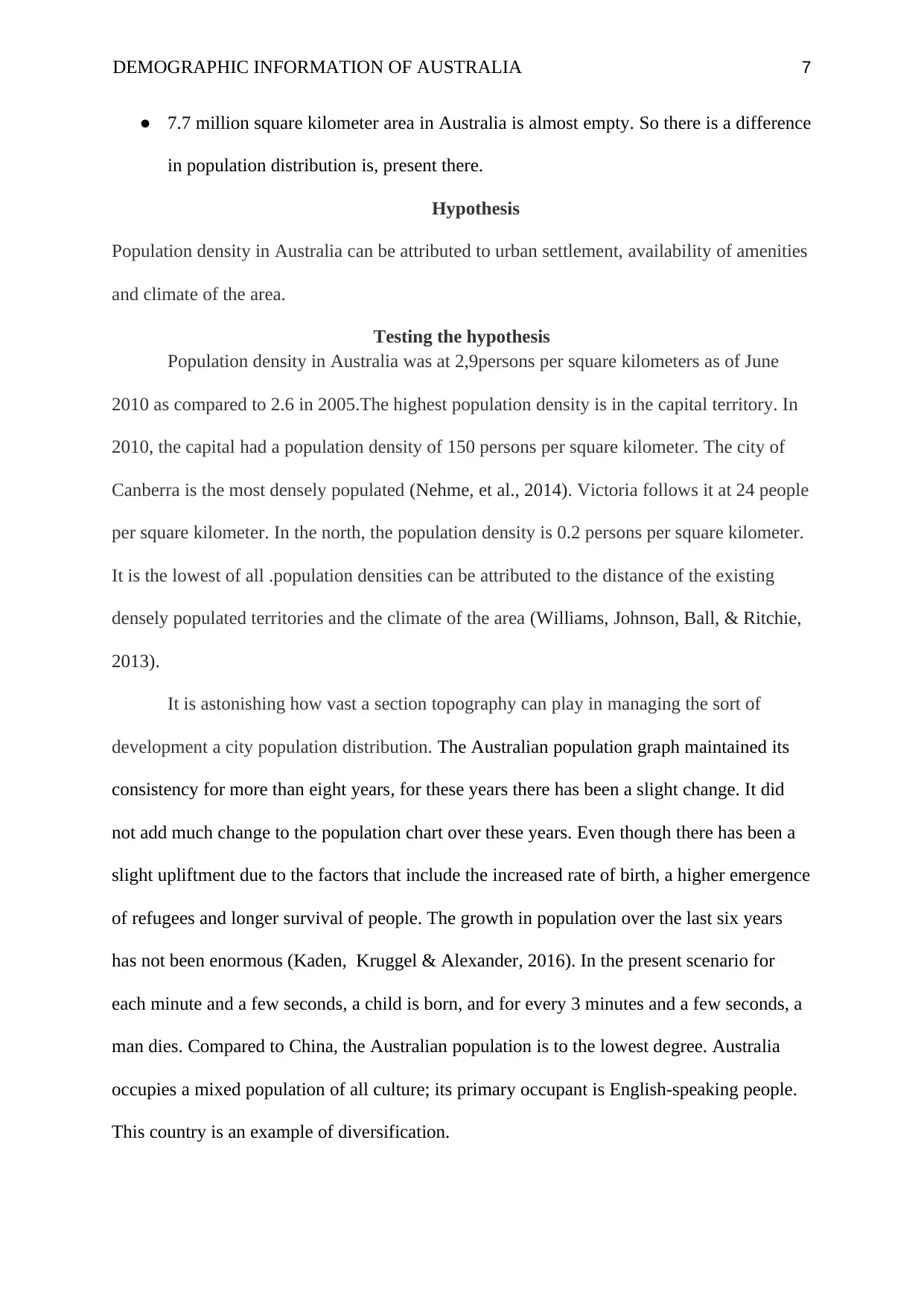
DEMOGRAPHIC INFORMATION OF AUSTRALIA 7
● 7.7 million square kilometer area in Australia is almost empty. So there is a difference
in population distribution is, present there.
Hypothesis
Population density in Australia can be attributed to urban settlement, availability of amenities
and climate of the area.
Testing the hypothesis
Population density in Australia was at 2,9persons per square kilometers as of June
2010 as compared to 2.6 in 2005.The highest population density is in the capital territory. In
2010, the capital had a population density of 150 persons per square kilometer. The city of
Canberra is the most densely populated (Nehme, et al., 2014). Victoria follows it at 24 people
per square kilometer. In the north, the population density is 0.2 persons per square kilometer.
It is the lowest of all .population densities can be attributed to the distance of the existing
densely populated territories and the climate of the area (Williams, Johnson, Ball, & Ritchie,
2013).
It is astonishing how vast a section topography can play in managing the sort of
development a city population distribution. The Australian population graph maintained its
consistency for more than eight years, for these years there has been a slight change. It did
not add much change to the population chart over these years. Even though there has been a
slight upliftment due to the factors that include the increased rate of birth, a higher emergence
of refugees and longer survival of people. The growth in population over the last six years
has not been enormous (Kaden, Kruggel & Alexander, 2016). In the present scenario for
each minute and a few seconds, a child is born, and for every 3 minutes and a few seconds, a
man dies. Compared to China, the Australian population is to the lowest degree. Australia
occupies a mixed population of all culture; its primary occupant is English-speaking people.
This country is an example of diversification.
● 7.7 million square kilometer area in Australia is almost empty. So there is a difference
in population distribution is, present there.
Hypothesis
Population density in Australia can be attributed to urban settlement, availability of amenities
and climate of the area.
Testing the hypothesis
Population density in Australia was at 2,9persons per square kilometers as of June
2010 as compared to 2.6 in 2005.The highest population density is in the capital territory. In
2010, the capital had a population density of 150 persons per square kilometer. The city of
Canberra is the most densely populated (Nehme, et al., 2014). Victoria follows it at 24 people
per square kilometer. In the north, the population density is 0.2 persons per square kilometer.
It is the lowest of all .population densities can be attributed to the distance of the existing
densely populated territories and the climate of the area (Williams, Johnson, Ball, & Ritchie,
2013).
It is astonishing how vast a section topography can play in managing the sort of
development a city population distribution. The Australian population graph maintained its
consistency for more than eight years, for these years there has been a slight change. It did
not add much change to the population chart over these years. Even though there has been a
slight upliftment due to the factors that include the increased rate of birth, a higher emergence
of refugees and longer survival of people. The growth in population over the last six years
has not been enormous (Kaden, Kruggel & Alexander, 2016). In the present scenario for
each minute and a few seconds, a child is born, and for every 3 minutes and a few seconds, a
man dies. Compared to China, the Australian population is to the lowest degree. Australia
occupies a mixed population of all culture; its primary occupant is English-speaking people.
This country is an example of diversification.
Paraphrase This Document
Need a fresh take? Get an instant paraphrase of this document with our AI Paraphraser
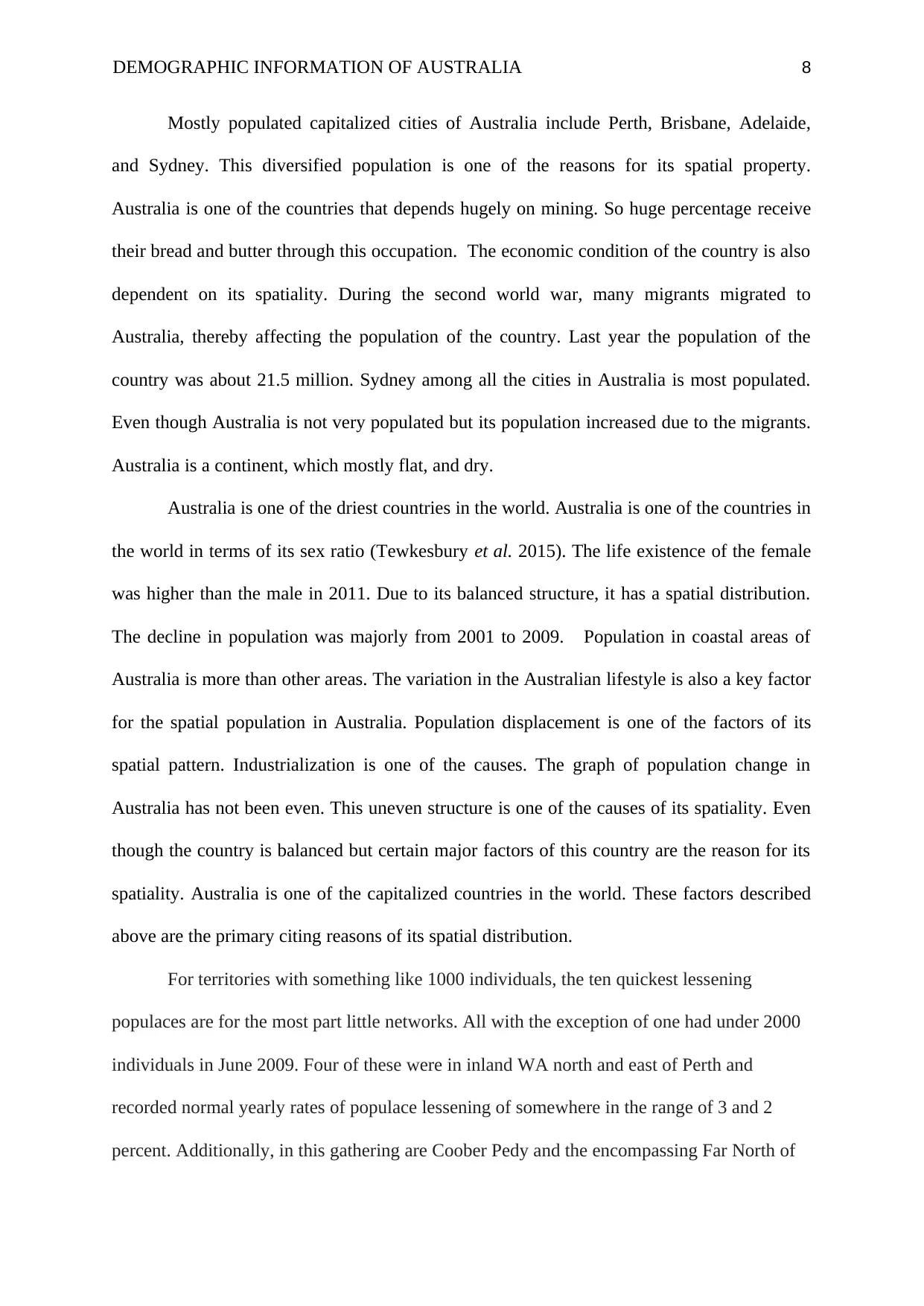
DEMOGRAPHIC INFORMATION OF AUSTRALIA 8
Mostly populated capitalized cities of Australia include Perth, Brisbane, Adelaide,
and Sydney. This diversified population is one of the reasons for its spatial property.
Australia is one of the countries that depends hugely on mining. So huge percentage receive
their bread and butter through this occupation. The economic condition of the country is also
dependent on its spatiality. During the second world war, many migrants migrated to
Australia, thereby affecting the population of the country. Last year the population of the
country was about 21.5 million. Sydney among all the cities in Australia is most populated.
Even though Australia is not very populated but its population increased due to the migrants.
Australia is a continent, which mostly flat, and dry.
Australia is one of the driest countries in the world. Australia is one of the countries in
the world in terms of its sex ratio (Tewkesbury et al. 2015). The life existence of the female
was higher than the male in 2011. Due to its balanced structure, it has a spatial distribution.
The decline in population was majorly from 2001 to 2009. Population in coastal areas of
Australia is more than other areas. The variation in the Australian lifestyle is also a key factor
for the spatial population in Australia. Population displacement is one of the factors of its
spatial pattern. Industrialization is one of the causes. The graph of population change in
Australia has not been even. This uneven structure is one of the causes of its spatiality. Even
though the country is balanced but certain major factors of this country are the reason for its
spatiality. Australia is one of the capitalized countries in the world. These factors described
above are the primary citing reasons of its spatial distribution.
For territories with something like 1000 individuals, the ten quickest lessening
populaces are for the most part little networks. All with the exception of one had under 2000
individuals in June 2009. Four of these were in inland WA north and east of Perth and
recorded normal yearly rates of populace lessening of somewhere in the range of 3 and 2
percent. Additionally, in this gathering are Coober Pedy and the encompassing Far North of
Mostly populated capitalized cities of Australia include Perth, Brisbane, Adelaide,
and Sydney. This diversified population is one of the reasons for its spatial property.
Australia is one of the countries that depends hugely on mining. So huge percentage receive
their bread and butter through this occupation. The economic condition of the country is also
dependent on its spatiality. During the second world war, many migrants migrated to
Australia, thereby affecting the population of the country. Last year the population of the
country was about 21.5 million. Sydney among all the cities in Australia is most populated.
Even though Australia is not very populated but its population increased due to the migrants.
Australia is a continent, which mostly flat, and dry.
Australia is one of the driest countries in the world. Australia is one of the countries in
the world in terms of its sex ratio (Tewkesbury et al. 2015). The life existence of the female
was higher than the male in 2011. Due to its balanced structure, it has a spatial distribution.
The decline in population was majorly from 2001 to 2009. Population in coastal areas of
Australia is more than other areas. The variation in the Australian lifestyle is also a key factor
for the spatial population in Australia. Population displacement is one of the factors of its
spatial pattern. Industrialization is one of the causes. The graph of population change in
Australia has not been even. This uneven structure is one of the causes of its spatiality. Even
though the country is balanced but certain major factors of this country are the reason for its
spatiality. Australia is one of the capitalized countries in the world. These factors described
above are the primary citing reasons of its spatial distribution.
For territories with something like 1000 individuals, the ten quickest lessening
populaces are for the most part little networks. All with the exception of one had under 2000
individuals in June 2009. Four of these were in inland WA north and east of Perth and
recorded normal yearly rates of populace lessening of somewhere in the range of 3 and 2
percent. Additionally, in this gathering are Coober Pedy and the encompassing Far North of
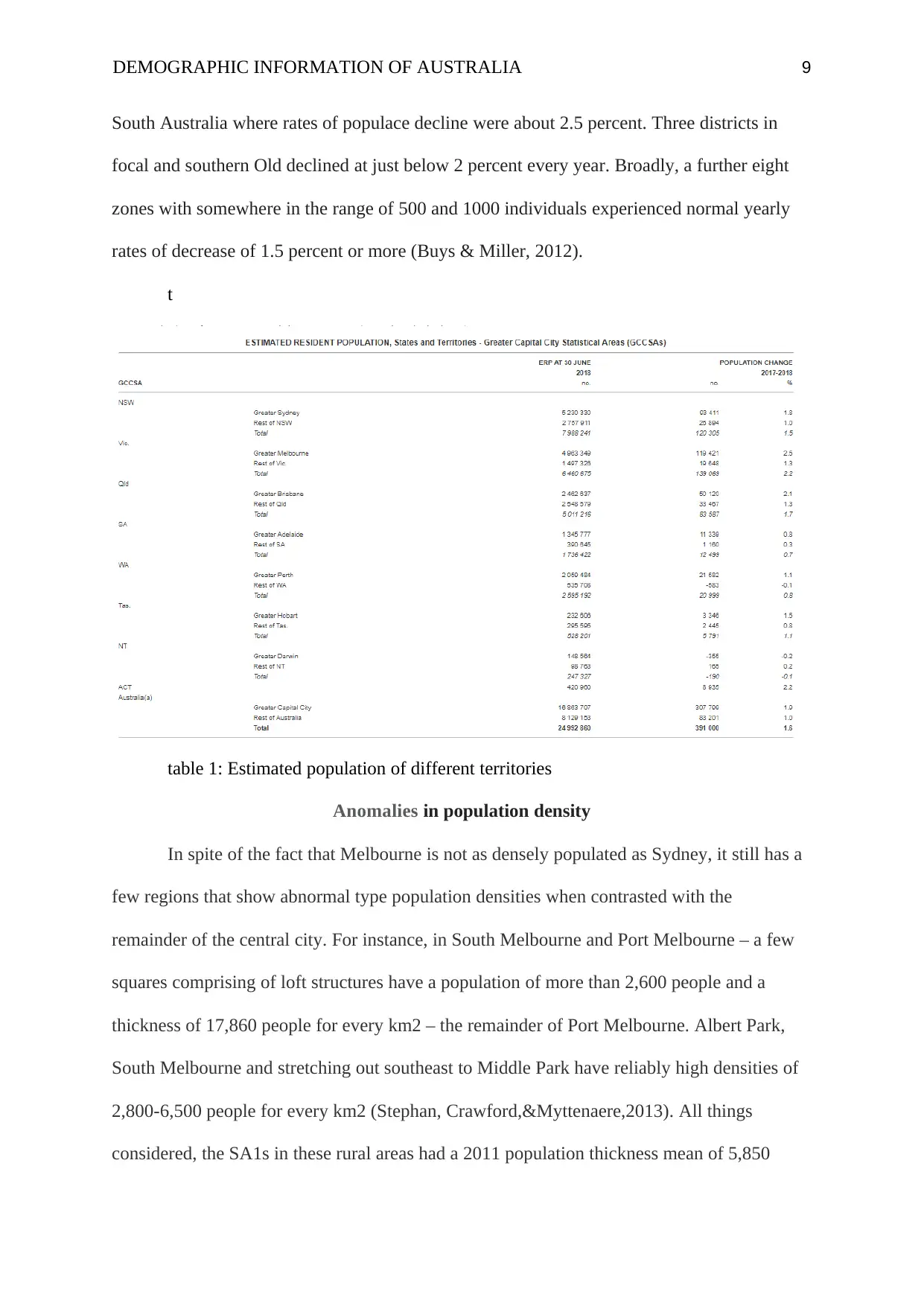
DEMOGRAPHIC INFORMATION OF AUSTRALIA 9
South Australia where rates of populace decline were about 2.5 percent. Three districts in
focal and southern Old declined at just below 2 percent every year. Broadly, a further eight
zones with somewhere in the range of 500 and 1000 individuals experienced normal yearly
rates of decrease of 1.5 percent or more (Buys & Miller, 2012).
t
table 1: Estimated population of different territories
Anomalies in population density
In spite of the fact that Melbourne is not as densely populated as Sydney, it still has a
few regions that show abnormal type population densities when contrasted with the
remainder of the central city. For instance, in South Melbourne and Port Melbourne – a few
squares comprising of loft structures have a population of more than 2,600 people and a
thickness of 17,860 people for every km2 – the remainder of Port Melbourne. Albert Park,
South Melbourne and stretching out southeast to Middle Park have reliably high densities of
2,800-6,500 people for every km2 (Stephan, Crawford,&Myttenaere,2013). All things
considered, the SA1s in these rural areas had a 2011 population thickness mean of 5,850
South Australia where rates of populace decline were about 2.5 percent. Three districts in
focal and southern Old declined at just below 2 percent every year. Broadly, a further eight
zones with somewhere in the range of 500 and 1000 individuals experienced normal yearly
rates of decrease of 1.5 percent or more (Buys & Miller, 2012).
t
table 1: Estimated population of different territories
Anomalies in population density
In spite of the fact that Melbourne is not as densely populated as Sydney, it still has a
few regions that show abnormal type population densities when contrasted with the
remainder of the central city. For instance, in South Melbourne and Port Melbourne – a few
squares comprising of loft structures have a population of more than 2,600 people and a
thickness of 17,860 people for every km2 – the remainder of Port Melbourne. Albert Park,
South Melbourne and stretching out southeast to Middle Park have reliably high densities of
2,800-6,500 people for every km2 (Stephan, Crawford,&Myttenaere,2013). All things
considered, the SA1s in these rural areas had a 2011 population thickness mean of 5,850
⊘ This is a preview!⊘
Do you want full access?
Subscribe today to unlock all pages.

Trusted by 1+ million students worldwide
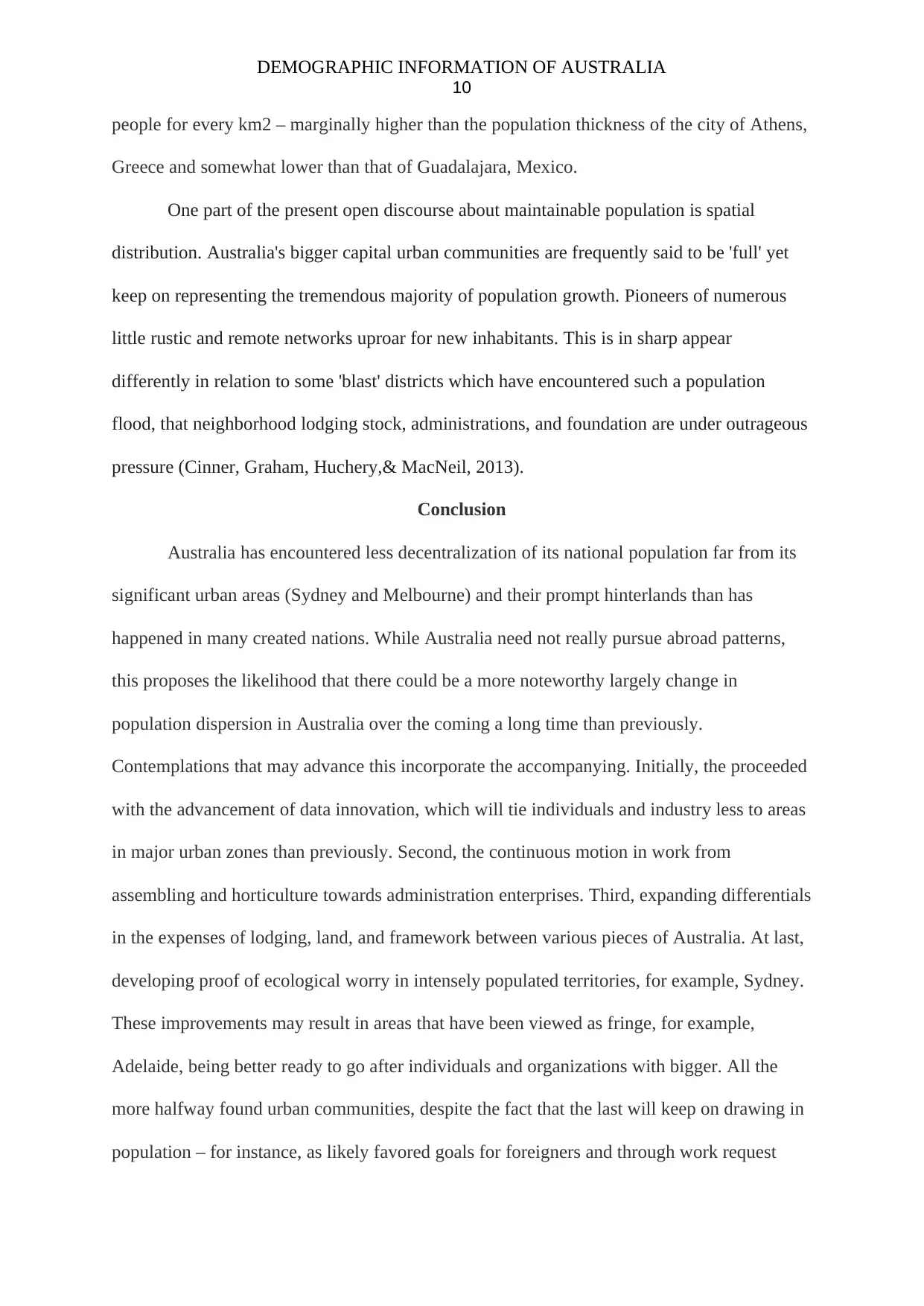
DEMOGRAPHIC INFORMATION OF AUSTRALIA
10
people for every km2 – marginally higher than the population thickness of the city of Athens,
Greece and somewhat lower than that of Guadalajara, Mexico.
One part of the present open discourse about maintainable population is spatial
distribution. Australia's bigger capital urban communities are frequently said to be 'full' yet
keep on representing the tremendous majority of population growth. Pioneers of numerous
little rustic and remote networks uproar for new inhabitants. This is in sharp appear
differently in relation to some 'blast' districts which have encountered such a population
flood, that neighborhood lodging stock, administrations, and foundation are under outrageous
pressure (Cinner, Graham, Huchery,& MacNeil, 2013).
Conclusion
Australia has encountered less decentralization of its national population far from its
significant urban areas (Sydney and Melbourne) and their prompt hinterlands than has
happened in many created nations. While Australia need not really pursue abroad patterns,
this proposes the likelihood that there could be a more noteworthy largely change in
population dispersion in Australia over the coming a long time than previously.
Contemplations that may advance this incorporate the accompanying. Initially, the proceeded
with the advancement of data innovation, which will tie individuals and industry less to areas
in major urban zones than previously. Second, the continuous motion in work from
assembling and horticulture towards administration enterprises. Third, expanding differentials
in the expenses of lodging, land, and framework between various pieces of Australia. At last,
developing proof of ecological worry in intensely populated territories, for example, Sydney.
These improvements may result in areas that have been viewed as fringe, for example,
Adelaide, being better ready to go after individuals and organizations with bigger. All the
more halfway found urban communities, despite the fact that the last will keep on drawing in
population – for instance, as likely favored goals for foreigners and through work request
10
people for every km2 – marginally higher than the population thickness of the city of Athens,
Greece and somewhat lower than that of Guadalajara, Mexico.
One part of the present open discourse about maintainable population is spatial
distribution. Australia's bigger capital urban communities are frequently said to be 'full' yet
keep on representing the tremendous majority of population growth. Pioneers of numerous
little rustic and remote networks uproar for new inhabitants. This is in sharp appear
differently in relation to some 'blast' districts which have encountered such a population
flood, that neighborhood lodging stock, administrations, and foundation are under outrageous
pressure (Cinner, Graham, Huchery,& MacNeil, 2013).
Conclusion
Australia has encountered less decentralization of its national population far from its
significant urban areas (Sydney and Melbourne) and their prompt hinterlands than has
happened in many created nations. While Australia need not really pursue abroad patterns,
this proposes the likelihood that there could be a more noteworthy largely change in
population dispersion in Australia over the coming a long time than previously.
Contemplations that may advance this incorporate the accompanying. Initially, the proceeded
with the advancement of data innovation, which will tie individuals and industry less to areas
in major urban zones than previously. Second, the continuous motion in work from
assembling and horticulture towards administration enterprises. Third, expanding differentials
in the expenses of lodging, land, and framework between various pieces of Australia. At last,
developing proof of ecological worry in intensely populated territories, for example, Sydney.
These improvements may result in areas that have been viewed as fringe, for example,
Adelaide, being better ready to go after individuals and organizations with bigger. All the
more halfway found urban communities, despite the fact that the last will keep on drawing in
population – for instance, as likely favored goals for foreigners and through work request
Paraphrase This Document
Need a fresh take? Get an instant paraphrase of this document with our AI Paraphraser
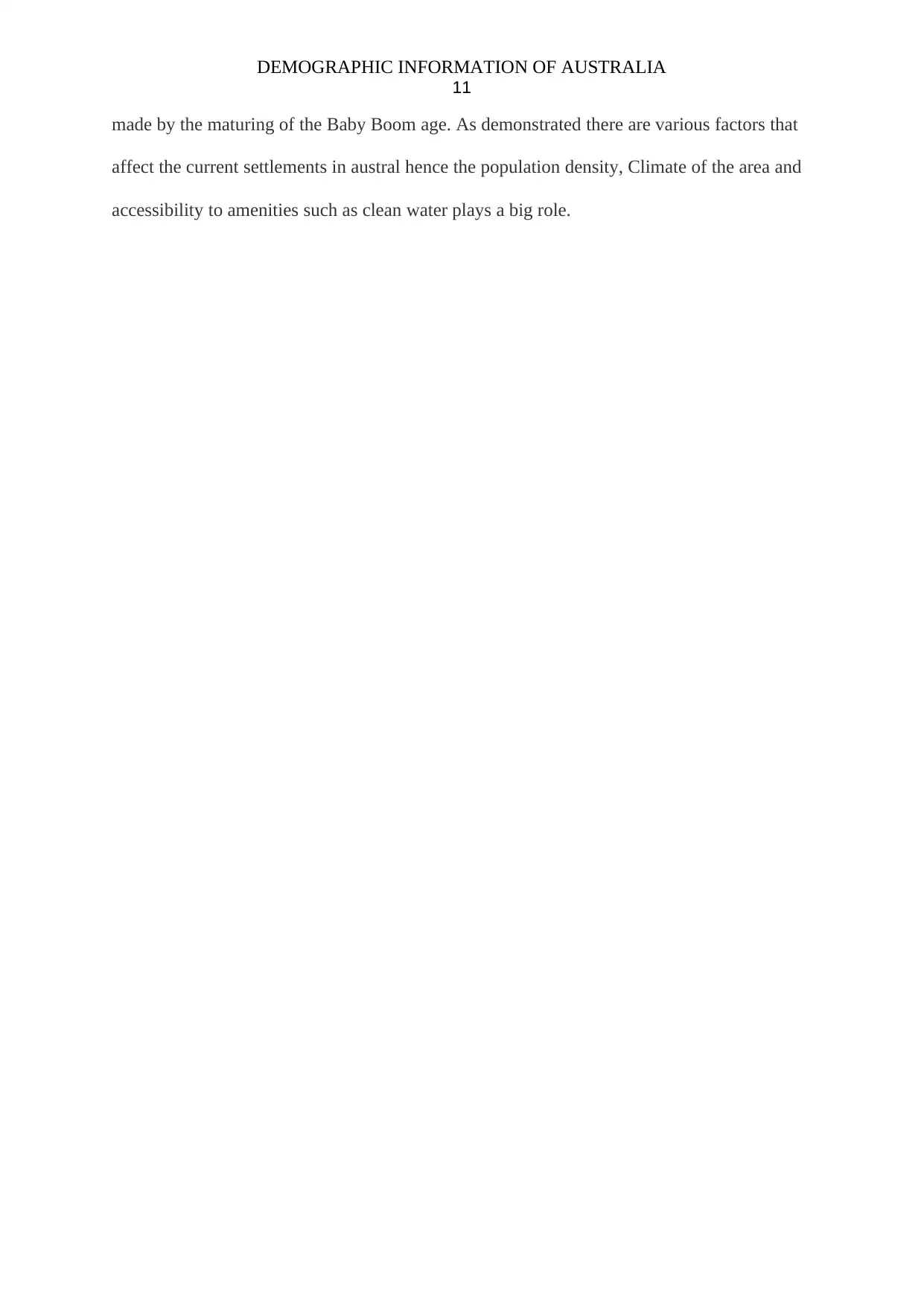
DEMOGRAPHIC INFORMATION OF AUSTRALIA
11
made by the maturing of the Baby Boom age. As demonstrated there are various factors that
affect the current settlements in austral hence the population density, Climate of the area and
accessibility to amenities such as clean water plays a big role.
11
made by the maturing of the Baby Boom age. As demonstrated there are various factors that
affect the current settlements in austral hence the population density, Climate of the area and
accessibility to amenities such as clean water plays a big role.
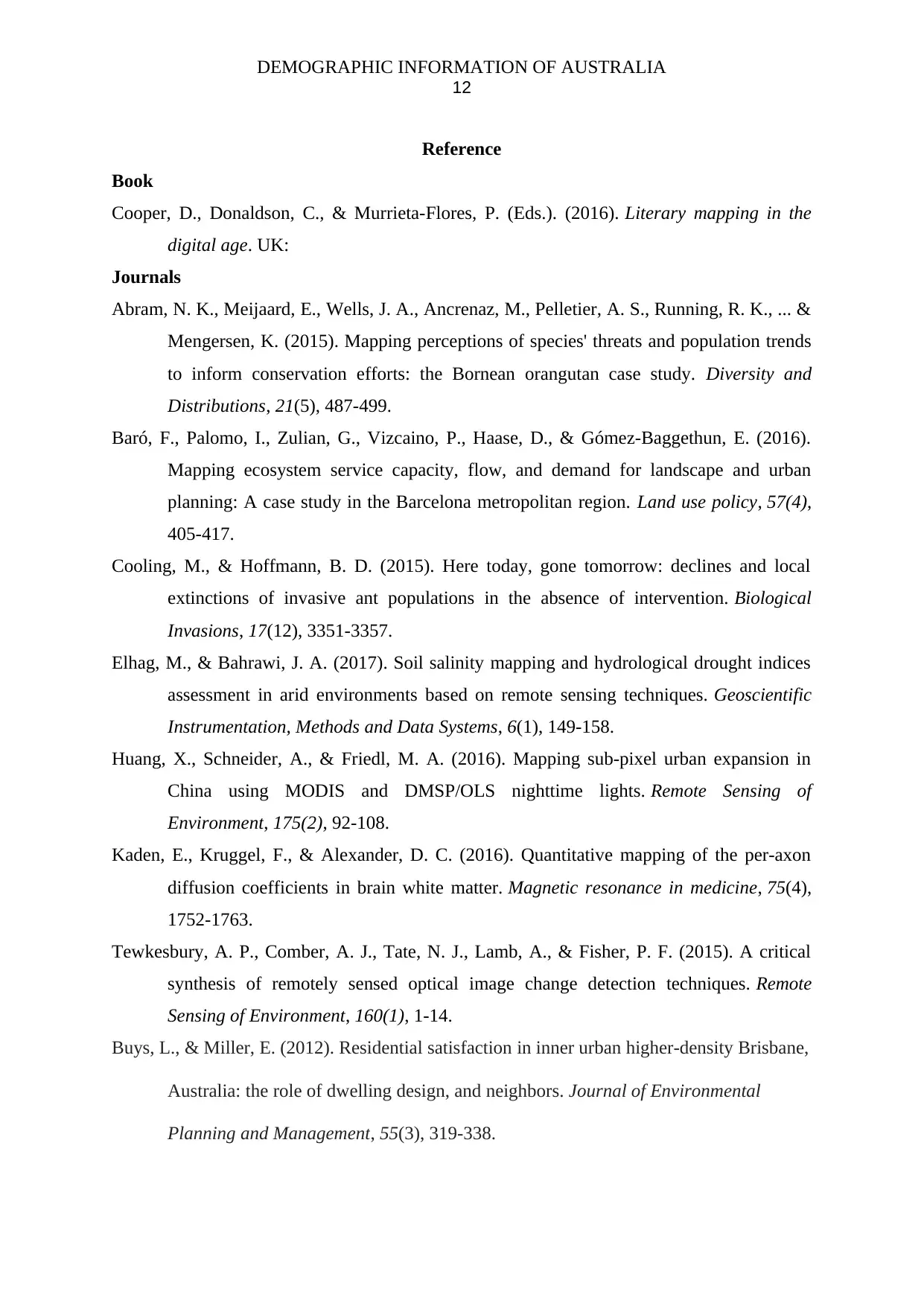
DEMOGRAPHIC INFORMATION OF AUSTRALIA
12
Reference
Book
Cooper, D., Donaldson, C., & Murrieta-Flores, P. (Eds.). (2016). Literary mapping in the
digital age. UK:
Journals
Abram, N. K., Meijaard, E., Wells, J. A., Ancrenaz, M., Pelletier, A. S., Running, R. K., ... &
Mengersen, K. (2015). Mapping perceptions of species' threats and population trends
to inform conservation efforts: the Bornean orangutan case study. Diversity and
Distributions, 21(5), 487-499.
Baró, F., Palomo, I., Zulian, G., Vizcaino, P., Haase, D., & Gómez-Baggethun, E. (2016).
Mapping ecosystem service capacity, flow, and demand for landscape and urban
planning: A case study in the Barcelona metropolitan region. Land use policy, 57(4),
405-417.
Cooling, M., & Hoffmann, B. D. (2015). Here today, gone tomorrow: declines and local
extinctions of invasive ant populations in the absence of intervention. Biological
Invasions, 17(12), 3351-3357.
Elhag, M., & Bahrawi, J. A. (2017). Soil salinity mapping and hydrological drought indices
assessment in arid environments based on remote sensing techniques. Geoscientific
Instrumentation, Methods and Data Systems, 6(1), 149-158.
Huang, X., Schneider, A., & Friedl, M. A. (2016). Mapping sub-pixel urban expansion in
China using MODIS and DMSP/OLS nighttime lights. Remote Sensing of
Environment, 175(2), 92-108.
Kaden, E., Kruggel, F., & Alexander, D. C. (2016). Quantitative mapping of the per‐axon
diffusion coefficients in brain white matter. Magnetic resonance in medicine, 75(4),
1752-1763.
Tewkesbury, A. P., Comber, A. J., Tate, N. J., Lamb, A., & Fisher, P. F. (2015). A critical
synthesis of remotely sensed optical image change detection techniques. Remote
Sensing of Environment, 160(1), 1-14.
Buys, L., & Miller, E. (2012). Residential satisfaction in inner urban higher-density Brisbane,
Australia: the role of dwelling design, and neighbors. Journal of Environmental
Planning and Management, 55(3), 319-338.
12
Reference
Book
Cooper, D., Donaldson, C., & Murrieta-Flores, P. (Eds.). (2016). Literary mapping in the
digital age. UK:
Journals
Abram, N. K., Meijaard, E., Wells, J. A., Ancrenaz, M., Pelletier, A. S., Running, R. K., ... &
Mengersen, K. (2015). Mapping perceptions of species' threats and population trends
to inform conservation efforts: the Bornean orangutan case study. Diversity and
Distributions, 21(5), 487-499.
Baró, F., Palomo, I., Zulian, G., Vizcaino, P., Haase, D., & Gómez-Baggethun, E. (2016).
Mapping ecosystem service capacity, flow, and demand for landscape and urban
planning: A case study in the Barcelona metropolitan region. Land use policy, 57(4),
405-417.
Cooling, M., & Hoffmann, B. D. (2015). Here today, gone tomorrow: declines and local
extinctions of invasive ant populations in the absence of intervention. Biological
Invasions, 17(12), 3351-3357.
Elhag, M., & Bahrawi, J. A. (2017). Soil salinity mapping and hydrological drought indices
assessment in arid environments based on remote sensing techniques. Geoscientific
Instrumentation, Methods and Data Systems, 6(1), 149-158.
Huang, X., Schneider, A., & Friedl, M. A. (2016). Mapping sub-pixel urban expansion in
China using MODIS and DMSP/OLS nighttime lights. Remote Sensing of
Environment, 175(2), 92-108.
Kaden, E., Kruggel, F., & Alexander, D. C. (2016). Quantitative mapping of the per‐axon
diffusion coefficients in brain white matter. Magnetic resonance in medicine, 75(4),
1752-1763.
Tewkesbury, A. P., Comber, A. J., Tate, N. J., Lamb, A., & Fisher, P. F. (2015). A critical
synthesis of remotely sensed optical image change detection techniques. Remote
Sensing of Environment, 160(1), 1-14.
Buys, L., & Miller, E. (2012). Residential satisfaction in inner urban higher-density Brisbane,
Australia: the role of dwelling design, and neighbors. Journal of Environmental
Planning and Management, 55(3), 319-338.
⊘ This is a preview!⊘
Do you want full access?
Subscribe today to unlock all pages.

Trusted by 1+ million students worldwide
1 out of 13
Related Documents
Your All-in-One AI-Powered Toolkit for Academic Success.
+13062052269
info@desklib.com
Available 24*7 on WhatsApp / Email
![[object Object]](/_next/static/media/star-bottom.7253800d.svg)
Unlock your academic potential
Copyright © 2020–2025 A2Z Services. All Rights Reserved. Developed and managed by ZUCOL.





